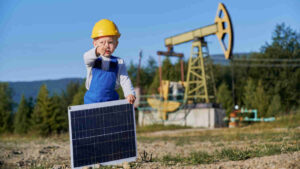The Ethical Investor: Investing opportunities abound in the ‘ESG paradox’, and where to find them on ASX

Opportunities abound if investors just think through the ESG paradox, says Aniket Shah of Jeffries. Picture Getty
- Aniket Shah of Jeffries explains the paradox surrounding ESG
- Opportunities are plenty if investors just think through this paradox, he says
- And which ASX stocks fit into Shah’s thematics?
Aniket Shah, global head of ESG strategy at asset management company Jefferies, says there are two ways to look at ESG.
The first is through three separate lenses – environmental, social, and governance – which allow you, as an investor, to better analyse a company’s intangibles.
“These will enable you to understand a company’s externalities, with the idea that a company’s intangibles and externalities actually drive a lot of their value in today’s market conditions,” Shah told Bloomberg.
The other way of looking at ESG, according to Shah, is through a thematic.
“And here, the energy transition is really front and centre to most global investors,” he said.
Shah believes that global investors need to think very thoughtfully about the energy transition, because it’s much more complicated than what meets the eye.
“There is a paradox that investors are dealing with right now,” he said.
On the one hand, there’s so much enthusiasm around a transition to a low carbon economy where over US$70 trillion of capital globally has signed on to be net zero by 2050.
Over 90% of the world’s emissions today are under some type of net zero umbrella by 2050, with US$1.7 trillion invested in solar, wind, electric vehicles, hydro and non-fossil fuel technologies in 2023 alone.
“And yet at the same time, despite all this enthusiasm and excitement, 80% of the world’s primary energy still comes from fossil fuels,” Shah said.
“Oil demand is at all time high, coal demand is at an all time high, and gas demand is at all time high.
“And that’s a really difficult paradox because investors are hearing a narrative on the one hand, but then in the real world, things are very stubbornly not changing.”
‘Lots of opportunities’ in energy transition
Despite a 5x increase in global investments in energy transition over the last eight years since the Paris Agreement, the world is still woefully behind when it comes to energy transition investments.
According to Bloomberg New Energy Finance, we were at US$350 billion or so in 2015, and this year we’ll be at around US$1.7 trillion.
In addition, there’s going to be a billion dollars invested a day in solar around the world.
“So we are seeing an exponential rise in energy transition investments, but that’s not enough,” said Shah.
He believes the amount needed to get to net zero should be more around $4 trillion to US$5 trillion per year, adding that this huge shortfall provides lots of interesting investment opportunities if investors just “think through the paradox in a thoughtful way.”
“We’re making the case to our clients that they should invest a lot more in climate adaptation.
“This means investing in companies and technologies that will allow the world to live in a warmer world, that will allow us to deal with for example, droughts,” Shah said.
That includes sectors such as water desalination and agricultural tech, he added.
“We’re also advocating to our clients to invest a lot more in the carbon removal industry, which we think is going to be a multibillion dollar industry within this decade,” said Shah.
He believes there are companies out there which already have the technology to remove CO2 in the atmosphere.
“And we also think investors need to spend more time looking at direct air capture by looking at a forestation and re-forestation, and so on, than they currently are.”
Who’s leading the charge?
Ironically, Shah said the current world’s leader in energy transition investing is China, a country which generates the most amount of greenhouse gases.
“If you just look at the hard numbers, China invests more in renewable energy than the next three countries combined.
“China’s going to contribute over 40% of solar installation this year, and we’re already seeing China’s leadership on the academic and research side in solar and wind,” said Shah.
The US, according to Shah, is trying to play catch-up with the Inflation Reduction Act likely to put between US$1 trillion and US$2 trillion of public investment into energy transition over the next decade.
“That’s a very important shift from where the US was just a few months ago. So I think the US is catching up.
“And then finally, Europe has a very top down regulatory driven approach to net zero, and we’re seeing a lot of activity there.
“Europe is actually starting in a pretty good position when it comes to climate and the energy transition, and they’ll continue along their ways,” Shah added.
Some ASX stocks that fit into the theme
On the ASX, some of the companies that fit into Shah’s thematics include:
Fluence provides water purification systems and water supply services to the following four markets: Municipal wastewater treatment, industrial wastewater treatment, wastewater to energy, and water desalination.
The company owns a suite of patented and old-school water treatment techniques, with a focus on build-own-operate contracts and other recurring revenue.
Fluence says its flagship proprietary Membrane Aerated Bio Reactor (MABR) wastewater treatment solutions are addressing a $100bn+ market opportunity.
The company’s Smart Product Solutions have have also grown significantly, with over 750 plants sold.
Fluence has a broad international footprint and focuses on high growth markets including China, the Middle East, South East Asia, North America and Africa.
Rubicon is focusing on water scarcity by providing solutions to governments, water management utilities, and growers.
The company designs, manufactures, installs and maintains irrigation automation software and hardware, with the aim of maximising water availability and agricultural productivity through improved irrigation water use efficiency.
Recently, chairman Gordon Dickinson purchased more than $1.1 million worth of Rubicon shares.
CEO Bruce Rodgerson, executive director David Aughton and independent non-executive director Lynda O’Grady also stumped up for shares in RWL recently.
De.mem operates in the industrial segment providing water systems and solutions to clients from the mining, electronics, chemicals, oil & gas and the food & beverage industries as well as in the municipal and residential sectors.
With its core business model focusing on the treatment, re-use and recycling of industrial wastewater, De.mem says it is fulfilling an important environmental and social mission.
The company’s technology is co-developed with its research and development partner, Nanyang Technological University in Singapore, a world leader in membrane and water research.
The company’s sales have been growing, and during the first half CY23, it achieved record revenue of $10.7m.
Roots Sustainable Agricultural Technologies (ASX:ROO)
ROO is actively engaged in the commercialisation of solutions that tackle pressing challenges in the agricultural sector including plant climate management and the limited availability of water for irrigation.
ROO has several patented technologies which enable the adjustment of crop root temperatures as required, irrigation of crops with just humidity in the air, and heating or cooling of plant substrates in pots, grow bags or soil.
CEO Boaz Wachtel told Stockhead recently he believes the window to address the future of sustainable food production is closing fast.
“There are no easy answers, but they exist,” Wachtel said.
“Governments usually fail to support climate mitigation technologies in agriculture. This needs to change rapidly in order to meet the food security challenge for next generations.”
The company recently filed a US patent for its machine to control root zone, irrigation, and fertigation temperatures.
ROO says by controlling these three functions, the machine will provide plants with optimal growing conditions and a stable root zone temperature to achieve maximum yield.
Genex has a portfolio of more than $1bn of renewable energy generation and storage projects across Australia, including the company’s flagship Kidston Clean Energy Hub in North Queensland.
These projects including large-scale batteries, wind, solar and hydro – including the first pumped storage hydro project in Australia in over 40 years.
Overall the company said it has 100MW of renewable energy power in operation, has 300MW more under construction, and around 2.25GW in pipeline assets.
Genex also said these assets have saved around 650,000 tonnes of C02.
Calix has a technology it calls Project LEILAC (Low Emissions Intensity Lime and Cement), which reduces carbon dioxide emissions from cement.
Last year, Calix received $30 million from the Federal Government to develop a carbon, capture, use and storage (CCUS) project in NSW’s Southern Highland.
In collaboration with building products group Boral (ASX:BLD), the project is targeting 100,000 tonnes per year of CO2 capture, with Calix set to supply its Low Emission Intensity Lime and Cement (LEILAC) technology to the project.
Calix says the project objectives are aligned with the Government’s Technology Roadmap to reach net zero emissions by 2050, and to lower the cost of carbon credits to less than $20/tonne.
At Stockhead we tell it like it is. While Roots Sustainable Agricultural Technologies is a Stockhead advertiser, it did not sponsor this article.
Related Topics
UNLOCK INSIGHTS
Discover the untold stories of emerging ASX stocks.
Daily news and expert analysis, it's free to subscribe.
By proceeding, you confirm you understand that we handle personal information in accordance with our Privacy Policy.








